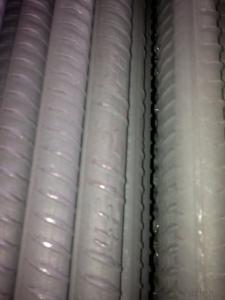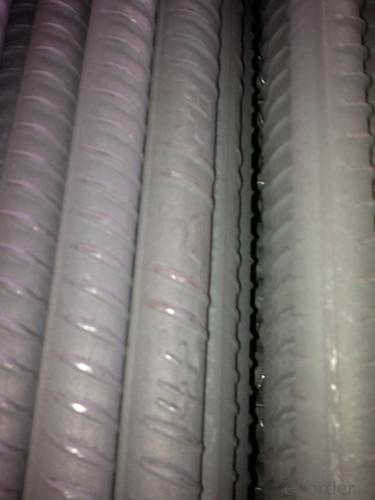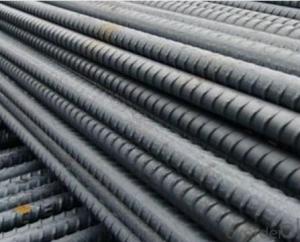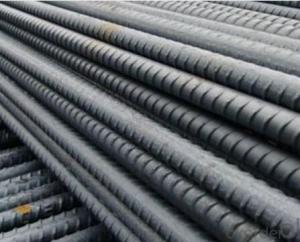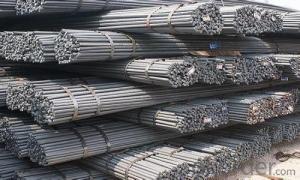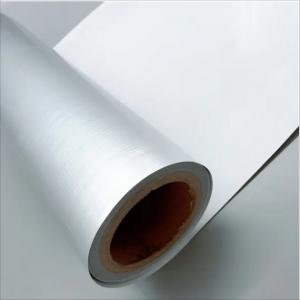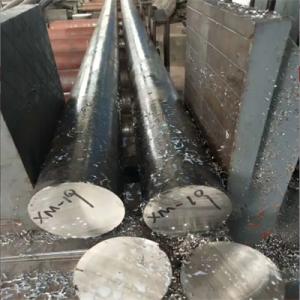Reinforcing Steel Sizes GB/UK/USA Standard Deformed Steel Bar
- Loading Port:
- China Main Port
- Payment Terms:
- TT or LC
- Min Order Qty:
- -
- Supply Capability:
- -
OKorder Service Pledge
OKorder Financial Service
You Might Also Like
Product Description:
OKorder is offering GB/UK/USA STANDARD Deformed Steel Bar at great prices with worldwide shipping. Our supplier is a world-class manufacturer of steel, with our products utilized the world over. OKorder annually supplies products to European, North American and Asian markets. We provide quotations within 24 hours of receiving an inquiry and guarantee competitive prices.
Product Applications:
GB/UK/USA STANDARD Deformed Steel Bar are ideal for structural applications and are widely used in the construction of buildings and bridges, and the manufacturing, petrochemical, and transportation industries.
Product Advantages:
OKorder's GB/UK/USA STANDARD Deformed Steel Bar are durable, strong, and resist corrosion.
Main Product Features:
· Premium quality
· Prompt delivery & seaworthy packing (30 days after receiving deposit)
· Corrosion resistance
· Can be recycled and reused
· Mill test certification
· Professional Service
· Competitive pricing
Product Specifications:
Specifications of Deformed Steel Bar:
Standard | GB | HRB335, HRB400, HRB500 | |
UK | G460B, B500A, B500B,B500C | ||
USA | GR40, GR60 | ||
Diameter | 6mm,8mm,10mm,12mm,14mm,16mm,18mm,20mm, 22mm,25mm,28mm,32mm,36mm,40mm,50mm | ||
Length | 6M, 9M,12M or as required | ||
Place of origin | China mainland | ||
Application | building,construction,road,bridge etc | ||
Brand name | DRAGON | ||
Theoretical weight and section area of each diameter as below for your information:
Diameter(mm) | Section area (mm²) | Mass(kg/m) |
6 | 28.27 | 0.222 |
8 | 50.27 | 0.395 |
10 | 78.54 | 0.617 |
12 | 113.1 | 0.888 |
14 | 153.9 | 1.21 |
16 | 201.1 | 1.58 |
18 | 254.5 | 2.00 |
20 | 314.2 | 2.47 |
22 | 380.1 | 2.98 |
25 | 490.9 | 3.85 |
28 | 615.8 | 4.83 |
32 | 804.2 | 6.31 |
36 | 1018 | 7.99 |
40 | 1257 | 9.87 |
50 | 1964 | 15.42 |
Usage and Applications of Deformed Steel Bar:
Deformed bar is widely used in buildings, bridges, roads and other engineering construction. Big to highways, railways, bridges, culverts, tunnels, public facilities such as flood control, dam, small to housing construction, beam, column, wall and the foundation of the plate, deformed bar is an integral structure material. With the development of world economy and the vigorous development of infrastructure construction, real estate, the demand for deformed bar will be larger and larger..
Packaging & Delivery of Deformed Steel Bar:
Packaging Detail: products are packed in bundle and then shipped by container or bulk vessel, deformed bar is usually naked strapping delivery, when storing, please pay attention to moisture proof. The performance of rust will produce adverse effect.
Each bundle weight: 2-3MT, or as required
Payment term: TT or L/C
Delivery Detail: within 45 days after received advanced payment or LC.
Label: to be specified by customer, generally, each bundle has 1-2 labels
Trade terms: FOB, CFR, CIF
Deformed Steel Bar in Coil
Produce Line of Deformed Steel Bar
Note:
1. Our products are produced according to national standard (GB), if not, supply according to national standards (GB) or agreement as customer required.
2. Other Grade and Standard Deformed Steel Bar we can supply:
Grade: GR40/GR60, G460B/B500A/B500B/B500C,BST500S
Standard: ASTM, BS, DIN
The Minimum Order Quantity of these products is high, and need to be confirmed.
3. We can not only supply Deformed Steel Bar; if you need anything about building materials, please contact us for further information.
4. Please send us your detail specifications when inquire. We will reply to you as soon as possible. We sincerely hope we can establish a long stable business relationship
FAQ:
Q1: Why buy Materials & Equipment from OKorder.com?
A1: All products offered byOKorder.com are carefully selected from China's most reliable manufacturing enterprises. Through its ISO certifications, OKorder.com adheres to the highest standards and a commitment to supply chain safety and customer satisfaction.
Q2: How do we guarantee the quality of our products?
A2: We have established an advanced quality management system which conducts strict quality tests at every step, from raw materials to the final product. At the same time, we provide extensive follow-up service assurances as required.
Q3: How soon can we receive the product after purchase?
A3: Within three days of placing an order, we will begin production. The specific shipping date is dependent upon international and government factors, but is typically 7 to 10 workdays.
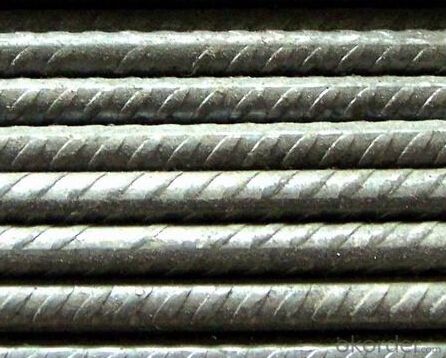

- Q:How are steel rebars used in the construction of wastewater treatment plants?
- Steel rebars are used in the construction of wastewater treatment plants to reinforce the concrete structures, such as tanks and basins, that are essential for storing and treating wastewater. The rebars provide strength and stability to these structures, ensuring they can withstand the weight of the water and the various chemicals used in the treatment process. Additionally, the rebars help to prevent cracking and structural failure, ensuring the longevity and reliability of the wastewater treatment plant.
- Q:Are there any environmental concerns related to the production of steel rebars?
- The production of steel rebars raises several environmental concerns, including the significant energy requirement for steel production. To produce steel, large amounts of fossil fuels like coal and natural gas are used, contributing to greenhouse gas emissions and climate change. Another concern is the extraction and mining of iron ore, the main raw material for steel production. This process can result in deforestation, habitat destruction, and soil erosion. Moreover, mining generates substantial waste material that can contaminate nearby water sources. In addition, the steel production process emits air pollutants such as particulate matter, sulfur dioxide, and nitrogen oxides. These pollutants can harm air quality and human health, causing respiratory problems and contributing to the formation of smog. It is worth noting that the steel industry is taking steps to address these environmental concerns. For instance, many steel producers are adopting more energy-efficient technologies and exploring alternative energy sources to reduce carbon emissions. Additionally, the recycling of steel is becoming more widespread, conserving resources and reducing the environmental impact of steel production. Overall, although the production of steel rebars does present environmental concerns, ongoing efforts are being made to mitigate these impacts and make the process more sustainable.
- Q:How do steel rebars affect the overall noise insulation of a structure?
- Steel rebars, being highly conductive materials, have a minimal impact on the overall noise insulation of a structure. They do not provide significant soundproofing properties and may even contribute to the transmission of sound waves through vibrations. To achieve effective noise insulation, additional soundproofing materials such as insulation boards or acoustic panels should be used alongside steel rebars.
- Q:Can steel rebars be used in architectural concrete elements?
- Indeed, architectural concrete elements can incorporate steel rebars for reinforcement, thereby augmenting the strength and longevity of the structure. It is customary to employ steel rebars in concrete construction as they fortify the concrete and enhance its durability. In the realm of architectural concrete, rebars can be tactically positioned to fortify the structural integrity of the elements, while simultaneously contributing to their visual appeal. Depending on the desired design outcome, these rebars can either be visibly exposed or discreetly concealed within the concrete. By utilizing steel rebars, architects possess the versatility to fashion intricate and distinctive architectural elements, all the while ensuring the requisite strength and stability.
- Q:How do steel rebars contribute to the load-bearing capacity of concrete slabs?
- Steel rebars contribute to the load-bearing capacity of concrete slabs by providing reinforcement and increasing the overall strength and durability of the structure. As concrete is strong in compression but weak in tension, steel rebars are embedded within the concrete to counteract tension forces. The rebars absorb and distribute the tensile stresses, preventing the concrete from cracking or failing under heavy loads. This combination of concrete and steel rebars creates a reinforced structure that can bear more weight and withstand various external forces, ensuring the integrity and safety of the concrete slab.
- Q:What is the carbon content of thread steel?
- The carbon content in the threaded steel is best about 1%, so that it can not only ensure the strength and hardness of the thread steel, but also ensure its plasticity and toughness.
- Q:Can steel rebars be used in swimming pools and water tanks?
- Yes, steel rebars can be used in swimming pools and water tanks. Steel rebars provide strength and durability to the concrete structures, making them suitable for withstanding the weight of the water and any external pressures. However, it is essential to ensure proper corrosion protection measures are in place to prevent the rebars from rusting due to the constant exposure to water.
- Q:Are steel rebars fire resistant?
- Yes, steel rebars are fire resistant.
- Q:What are the guidelines for handling and disposing of steel rebars after demolition?
- The guidelines for handling and disposing of steel rebars after demolition typically involve several steps. Firstly, the rebars should be carefully removed from the demolished structure using appropriate tools and equipment to ensure worker safety. Once removed, the rebars should be inspected for any damages or contaminants that may affect their reuse or recycling potential. If the rebars are in good condition, they can be cleaned and stored for future use in construction projects. However, if they are damaged or cannot be reused, they should be properly recycled. This involves sorting them based on their grade and size before sending them to a recycling facility. If recycling is not possible, the rebars should be disposed of in a designated landfill or waste management facility following local regulations and guidelines to minimize environmental impact. It is crucial to follow these guidelines to promote sustainable practices and reduce waste in the construction industry.
- Q:Can steel rebars be used in railway and transportation infrastructure?
- Railway and transportation infrastructure can utilize steel rebars, also known as reinforcing bars, to provide strength and support to concrete structures. These rebars are widely used in the construction industry to reinforce elements such as bridge piers, abutments, and retaining walls. The inclusion of steel rebars in railway and transportation infrastructure offers numerous benefits. Firstly, they increase the tensile strength of concrete, making structures more resistant to the dynamic and heavy loads imposed by trains and vehicles, particularly in bridges and elevated structures. Secondly, steel rebars ensure structural integrity and prevent the development of cracks and deformations in the concrete. This is vital for the long-term stability and safety of the infrastructure, considering the constant exposure to varying environmental conditions like temperature fluctuations and vibrations. Moreover, steel rebars exhibit high durability and corrosion resistance, which is crucial for railway and transportation infrastructure subjected to harsh weather conditions and chemical agents. Their ability to withstand these factors guarantees the longevity of the structures and minimizes the need for frequent repairs and maintenance. In conclusion, due to their ability to enhance the strength, durability, and stability of concrete structures, steel rebars are widely used in railway and transportation infrastructure. Their incorporation ensures the safe and reliable operation of these essential transportation systems, providing a solid foundation for the efficient movement of people and goods.
1. Manufacturer Overview |
|
|---|---|
| Location | |
| Year Established | |
| Annual Output Value | |
| Main Markets | |
| Company Certifications | |
2. Manufacturer Certificates |
|
|---|---|
| a) Certification Name | |
| Range | |
| Reference | |
| Validity Period | |
3. Manufacturer Capability |
|
|---|---|
| a)Trade Capacity | |
| Nearest Port | |
| Export Percentage | |
| No.of Employees in Trade Department | |
| Language Spoken: | |
| b)Factory Information | |
| Factory Size: | |
| No. of Production Lines | |
| Contract Manufacturing | |
| Product Price Range | |
Send your message to us
Reinforcing Steel Sizes GB/UK/USA Standard Deformed Steel Bar
- Loading Port:
- China Main Port
- Payment Terms:
- TT or LC
- Min Order Qty:
- -
- Supply Capability:
- -
OKorder Service Pledge
OKorder Financial Service
Similar products
New products
Hot products
Hot Searches
Related keywords
